- Home
- Bill Bryson
The Life and Times of the Thunderbolt Kid
The Life and Times of the Thunderbolt Kid Read online
Contents
TITLE PAGE
DEDICATION
FOREWORD AND ACKNOWLEDGMENTS
CHAPTER 1 • Hometown
CHAPTER 2 • Welcome to Kid World
CHAPTER 3 • Birth of a Superhero
CHAPTER 4 • The Age of Excitement
CHAPTER 5 • The Pursuit of Pleasure
CHAPTER 6 • Sex and Other Distractions
CHAPTER 7 • Boom!
CHAPTER 8 • School Days
CHAPTER 9 • Man at Work
CHAPTER 10 • Down on the Farm
CHAPTER 11 • What, Me Worry?
CHAPTER 12 • Out and About
CHAPTER 13 • The Pubic Years
CHAPTER 14 • Farewell
BIBLIOGRAPHY
ILLUSTRATION CREDITS
ABOUT THE AUTHOR
ALSO BY BILL BRYSON
COPYRIGHT
IN MEMORY OF JED MATTES
Foreword and Acknowledgments
My kid days were pretty good ones, on the whole. My parents were patient and kind and approximately normal. They didn’t chain me in the cellar. They didn’t call me “It.” I was born a boy and allowed to stay that way. My mother, as you’ll see, sent me to school once in Capri pants, but otherwise there was little trauma in my upbringing.
Growing up was easy. It required no thought or effort on my part. It was going to happen anyway. So what follows isn’t terribly eventful, I’m afraid. And yet it was by a very large margin the most fearful, thrilling, interesting, instructive, eye-popping, lustful, eager, troubled, untroubled, confused, serene, and unnerving time of my life. Coincidentally, it was all those things for America, too.
Everything recorded here is true and really happened, more or less, but nearly all the names and a few of the details have been changed in the hope of sparing embarrassment. A small part of the story originally appeared in somewhat different form in The New Yorker.
As ever, I have received generous help from many quarters, and I would like to thank here, sincerely and alphabetically, Aosaf Afzal, Matthew Angerer, Charles Elliott, Larry Finlay, Will Francis, Carol Heaton, Jay Horning, Patrick Janson-Smith, Tom and Nancy Jones, Fred Morris, Steve Rubin, Marianne Velmans, Daniel Wiles, and the staff of the Drake University and Des Moines Public Libraries in Iowa and Durham University Library in England.
I remain especially grateful to Gerry Howard, my astute and ever thoughtful American publisher, for a stack of Boys’ Life magazines, one of the best and most useful gifts I have had in years, and to Jack Peverill of Sarasota, Florida, for the provision of copious amounts of helpful material. And of course I remain perpetually grateful to my family, not least my dear wife, Cynthia, for more help than I could begin to list, to my brother, Michael, for much archival material, and to my incomparably wonderful, infinitely sporting mother, Mary McGuire Bryson, without whom, it goes without saying, nothing that follows would have been possible.
Chapter 1
HOMETOWN
SPRINGFIELD, ILL. (AP)—The State Senate of Illinois yesterday disbanded its Committee on Efficiency and Economy “for reasons of efficiency and economy.”
—Des Moines Tribune, February 6, 1955
IN THE LATE 1950S, the Royal Canadian Air Force produced a booklet on isometrics, a form of exercise that enjoyed a short but devoted vogue with my father. The idea of isometrics was that you used any unyielding object, like a tree or a wall, and pressed against it with all your might from various positions to tone and strengthen different groups of muscles. Since everybody already has access to trees and walls, you didn’t need to invest in a lot of costly equipment, which I expect was what attracted my dad.
What made it unfortunate in my father’s case is that he would do his isometrics on airplanes. At some point in every flight, he would stroll back to the galley area or the space by the emergency exit and, taking up the posture of someone trying to budge a very heavy piece of machinery, he would begin to push with his back or shoulder against the outer wall of the plane, pausing occasionally to take deep breaths before returning with quiet grunts to the task.
Since it looked uncannily, if unfathomably, as if he were trying to force a hole in the side of the plane, this naturally drew attention. Businessmen in nearby seats would stare over the tops of their glasses. A stewardess would pop her head out of the galley and likewise stare, but with a certain hard caution, as if remembering some aspect of her training that she had not previously been called upon to implement.
Seeing that he had observers, my father would straighten up and smile genially and begin to outline the engaging principles behind isometrics. Then he would give a demonstration to an audience that swiftly consisted of no one. He seemed curiously incapable of feeling embarrassment in such situations, but that was all right because I felt enough for both of us—indeed, enough for us and all the other passengers, the airline and its employees, and the whole of whatever state we were flying over.
Two things made these undertakings tolerable. The first was that back on solid ground my dad wasn’t half as foolish most of the time. The second was that the purpose of these trips was always to go to a Major League city, stay in a big downtown hotel, and attend ball games, and that excused a great deal—well, everything, in fact. My dad was a sportswriter for The Des Moines Register, which in those days was one of the country’s best papers, and often took me along on trips through the Midwest. Sometimes these were car trips to places like Sioux City or Burlington, but at least once a summer we boarded a big silver plane—a huge event in those days—and lumbered through the summery skies, up among the fleecy clouds, to St. Louis or Chicago or Detroit to take in a home stand. It was a kind of working holiday for my dad.
Baseball, like everything else, was part of a simpler world in those days, and I was allowed to go with him into the clubhouse and dugout and onto the field before games. I have had my hair tousled by Stan Musial. I have handed Willie Mays a ball that had skittered past him as he played catch. I have lent my binoculars to Harvey Kuenn (or possibly it was Billy Hoeft) so that he could scope some busty blonde in the upper deck. Once on a hot July afternoon I sat in a nearly airless clubhouse under the left-field grandstand at Wrigley Field beside Ernie Banks, the Cubs’ great shortstop, as he autographed boxes of new white baseballs (which are, incidentally, one of the most pleasurably aromatic things on earth, and worth spending time around anyway). Unbidden, I took it upon myself to sit beside him and pass him each new ball. This slowed the process considerably, but he gave a little smile each time and said thank you as if I had done him quite a favor. He was the nicest human being I have ever met. It was like being friends with God.
I CAN’T IMAGINE there has ever been a more gratifying time or place to be alive than America in the 1950s. No country had ever known such prosperity. When the war ended the United States had $26 billion worth of factories that hadn’t existed before the war, $140 billion in savings and war bonds just waiting to be spent, no bomb damage, and practically no competition. All that American companies had to do was stop making tanks and battleships and start making Buicks and Frigidaires—and boy did they.
By 1951, when I came sliding down the chute, almost 90 percent of American families had refrigerators, and nearly three-quarters had washing machines, telephones, vacuum cleaners, and gas or electric stoves—things that most of the rest of the world could still only fantasize about. Americans owned 80 percent of the world’s electrical goods, controlled two-thirds of the world’s productive capacity, produced more than 40 percent of its electricity, 60 percent of its oil, and 66 percent of its steel. The 5 percent of people on Earth who were Americans had more wealth than the oth
er 95 percent combined.
Remarkably, almost all this wealth was American made. Of the 7.5 million new cars sold in America in 1954, for instance, 99.93 percent were made in America by Americans. We became the richest country in the world without needing the rest of the world.
I don’t know of anything that better conveys the happy bounty of the age than a photograph (reproduced in this volume as the endpapers at the front and back of the book) that ran in Life magazine two weeks before my birth. It shows the Czekalinski family of Cleveland, Ohio—Steve, Stephanie, and two sons, Stephen and Henry—surrounded by the two and a half tons of food that a typical blue-collar family ate in a year. Among the items they were shown with were 450 pounds of flour, 72 pounds of shortening, 56 pounds of butter, 31 chickens, 300 pounds of beef, 25 pounds of carp, 144 pounds of ham, 39 pounds of coffee, 690 pounds of potatoes, 698 quarts of milk, 131 dozen eggs, 180 loaves of bread, and 8½ gallons of ice cream, all purchased on a budget of $25 a week. (Mr. Czekalinski made $1.96 an hour as a shipping clerk in a DuPont factory.) In 1951, the average American ate 50 percent more than the average European.
No wonder people were happy. Suddenly they were able to have things they had never dreamed of having, and they couldn’t believe their luck. There was, too, a wonderful simplicity of desire. It was the last time that people would be thrilled to own a toaster or waffle iron. If you bought a major appliance, you invited the neighbors around to have a look at it. When I was about four my parents bought an Amana Stor-Mor refrigerator and for at least six months it was like an honored guest in our kitchen. I’m sure they’d have drawn it up to the table at dinner if it hadn’t been so heavy. When visitors dropped by unexpectedly, my father would say: “Oh, Mary, is there any iced tea in the Amana?” Then to the guests he’d add significantly: “There usually is. It’s a Stor-Mor.”
“Oh, a Stor-Mor,” the male visitor would say and elevate his eyebrows in the manner of someone who appreciates quality cooling. “We thought about getting a Stor-Mor ourselves, but in the end we went for a Philco Shur-Kool. Alice loved the EZ-Glide vegetable drawer and you can get a full quart of ice cream in the freezer box. That was a big selling point for Wendell Junior, as you can imagine!”
They’d all have a good laugh at that and then sit around drinking iced tea and talking appliances for an hour or so. No human beings had ever been quite this happy before.
People looked forward to the future, too, in ways they never would again. Soon, according to every magazine, we were going to have underwater cities off every coast, space colonies inside giant spheres of glass, atomic trains and airliners, personal jet packs, a gyrocopter in every driveway, cars that turned into boats or even submarines, moving sidewalks to whisk us effortlessly to schools and offices, dome-roofed automobiles that drove themselves along sleek superhighways allowing Mom, Dad, and the two boys (Chip and Bud or Skip and Scooter) to play a board game or wave to a neighbor in a passing gyrocopter or just sit back and enjoy saying some of those splendid words that existed in the fifties and are no longer heard: mimeograph, rotisserie, stenographer, icebox, dime store, rutabaga, Studebaker, panty raid, bobby socks, Sputnik, beatnik, canasta, Cinerama, Moose Lodge, pinochle, daddy-o.
For those who couldn’t wait for underwater cities and self-driving cars, thousands of smaller enrichments were available right now. If you were to avail yourself of all that was on offer from advertisers in a single issue of, let’s say, Popular Science from, let’s say, December 1956, you could, among much else, teach yourself ventriloquism, learn to cut meat (by correspondence or in person at the National School of Meat Cutting in Toledo, Ohio), embark on a lucrative career sharpening skates door to door, arrange to sell fire extinguishers from home, end rupture troubles once and for all, build radios, repair radios, perform on radio, talk on radio to people in different countries and possibly on different planets, improve your personality, get a personality, acquire a manly physique, learn to dance, create personalized stationery for profit, or “MAKE BIG $$$$” in your spare time at home building lawn figures and other novelty ornaments.
My brother, who was normally quite an intelligent human being, once invested in a booklet that promised to teach him how to throw his voice. He would say something unintelligible through rigid lips, then quickly step aside and say, “That sounded like it came from over there, didn’t it?” He also saw an ad in Mechanics Illustrated that invited him to enjoy color television at home for 65 cents plus postage, placed an order, and four weeks later received in the mail a multicolored sheet of transparent plastic that he was instructed to tape over the television screen and watch the image through.
Having spent the money, my brother refused to accept that it was a touch disappointing. When a human face moved into the pinkish part of the screen or a section of lawn briefly coincided with the green portion, he would leap up in triumph. “Look! Look! That’s what color television’s gonna look like,” he would say. “This is all just experimental, you see.”
In fact, color television didn’t come to our neighborhood until nearly the end of the decade, when Mr. Kiessler on St. John’s Road bought an enormous RCA Victor Consolette, the flagship of the RCA fleet, for a lot of money. For at least two years his was the only known color television in private ownership, which made it a fantastic novelty. On Saturday evenings the children of the neighborhood would steal into his yard and stand in his flower beds to watch a program called My Living Doll through the double window behind his sofa. I am pretty certain that Mr. Kiessler didn’t realize that two dozen children of various ages and sizes were silently watching the TV with him or he wouldn’t have played with himself quite so enthusiastically every time the nubile Julie Newmar bounded onto the screen. I assumed it was some sort of isometrics.
EVERY YEAR FOR NEARLY FORTY YEARS, from 1945 until his retirement, my father went to the World Series for the Register. It was, by an immeasurably wide margin, the high point of his working year. Not only did he get to live it up for two weeks on expenses in some of the nation’s most cosmopolitan and exciting cities—and from Des Moines all cities are cosmopolitan and exciting—but he also got to witness many of the most memorable moments of baseball history: Al Gionfriddo’s miraculous one-handed catch of a Joe DiMaggio line drive in 1947, Don Larsen’s perfect game in 1956, Bill Mazeroski’s series-winning homer of 1960. These may mean nothing to you—they would mean nothing to most people these days, I suppose—but they were moments of near ecstasy that were shared by a nation.
In those days, World Series games were played during the day, so you had to play hooky or develop a convenient chest infection (“Jeez, Mom, the teacher said there’s a lot of TB going around”) if you wanted to see a game. Crowds would lingeringly gather wherever a radio was on or a TV played. Getting to watch or listen to any part of a World Series game, even half an inning at lunchtime, became a kind of illicit thrill. And if you did happen to be present when something monumental occurred, you would remember it for the rest of your life. My father had an uncanny knack for being there when such moments were made—never more so than in the seminal (and what an apt word that can sometimes be) season of 1951 when our story begins.
In the National League, the Brooklyn Dodgers had been cruising toward an easy pennant when, in mid-August, their crosstown rivals, the Giants, suddenly stirred to life and began a highly improbable comeback. Baseball in those days dominated the American psyche in a way that can scarcely be imagined now. Professional football and basketball existed, of course, and were followed, but essentially as minor spectacles that helped to pass the colder months until the baseball season resumed. The Super Bowl was years from its invention. The only sporting event that gripped the nation—the one time in the year when even your mom knew what was going on in the sporting world—was the World Series. And seldom did the race to reach the series hold America more firmly in thrall than in the late summer and early fall of 1951.
After months of comatose play, the Giants suddenly could do no wrong. They won
thirty-seven of forty-four games down the home stretch, cutting away at the Dodgers’ once-unassailable lead in what began to seem a fateful manner. By mid-September people talked of little else but whether the Dodgers could hold on. All across the nation fans dropped dead from the heat and excitement. When the dust cleared after the last day’s play, the standings showed the two teams with identical records, so a three-game playoff was hastily arranged to determine who could claim the pennant. The Register, like nearly all distant papers, didn’t dispatch a reporter to these impromptu playoffs, but elected to rely on wire services for its coverage until the series proper got under way.
The playoffs added three days to the nation’s exquisite torment. The two teams split the first two games, so it came down to a third, deciding game. At last the Dodgers appeared to recover their invincibility, taking a comfortable 4 to 1 lead into the ninth inning and needing just three outs to win. But the Giants scored a late run and put two more runners aboard when Bobby Thomson stepped to the plate. What Thomson did that afternoon in the gathering dusk of autumn has many times been voted the greatest moment in baseball history.
“Dodger reliever Ralph Branca threw a pitch that made history yesterday,” one of those present wrote. “Unfortunately it made history for someone else. Bobby Thomson, the ‘Flying Scotsman,’ swatted Branca’s second offering over the left field wall for a game-winning home run so momentous, so startling, that it was greeted with a moment’s stunned silence.
“Then, when realization of the miracle came, the double-decked stands of the Polo Grounds rocked on their forty-year-old foundations. The Giants had won the pennant, completing one of the unlikeliest comebacks baseball has ever seen.”
The author of those words was my father—who was abruptly, unexpectedly, present for Thomson’s moment of majesty. Goodness knows how he had talked the notoriously frugal management of the Register into sending him the 1,132 miles from Des Moines to New York for the crucial deciding game—an act of rash expenditure radically out of keeping with decades of careful precedent—or how he had managed to secure credentials and a place in the press box at such a late hour.

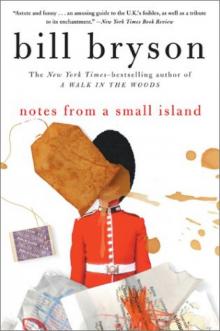 Notes from a Small Island
Notes from a Small Island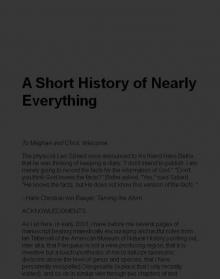 A Short History of Nearly Everything
A Short History of Nearly Everything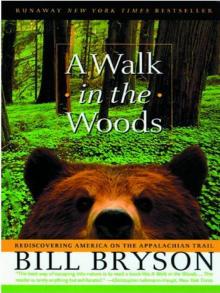 A Walk in the Woods
A Walk in the Woods I'm a Stranger Here Myself
I'm a Stranger Here Myself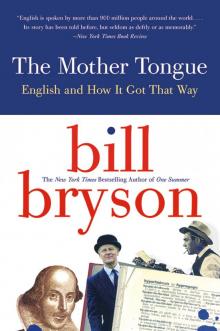 The Mother Tongue
The Mother Tongue Shakespeare
Shakespeare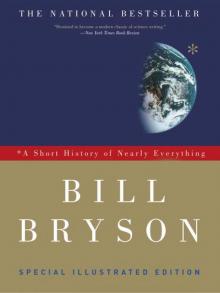 A Short History of Nearly Everything: Special Illustrated Edition
A Short History of Nearly Everything: Special Illustrated Edition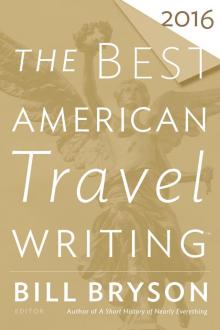 The Best American Travel Writing 2016
The Best American Travel Writing 2016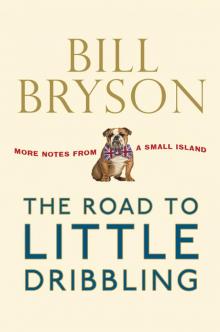 The Road to Little Dribbling
The Road to Little Dribbling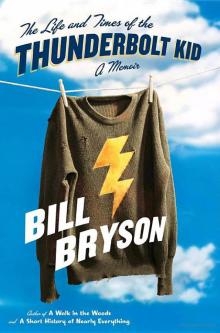 The Life And Times Of The Thunderbolt Kid: A Memoir (v5.0)
The Life And Times Of The Thunderbolt Kid: A Memoir (v5.0)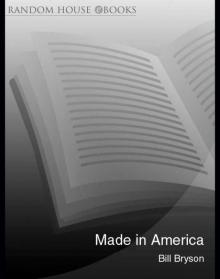 Made In America
Made In America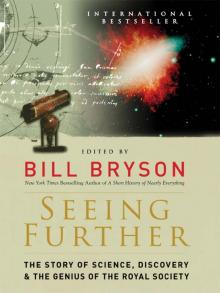 Seeing Further
Seeing Further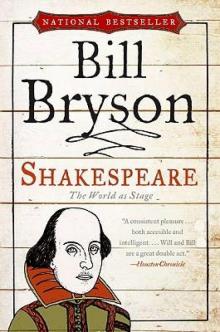 Shakespeare: The World as Stage
Shakespeare: The World as Stage The Life and Times of the Thunderbolt Kid
The Life and Times of the Thunderbolt Kid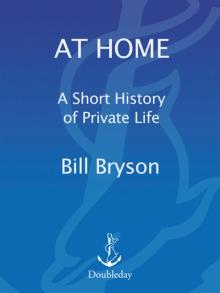 At Home
At Home Bryson's Dictionary For Writers And Editors (v5.0)
Bryson's Dictionary For Writers And Editors (v5.0) Neither Here Nor There
Neither Here Nor There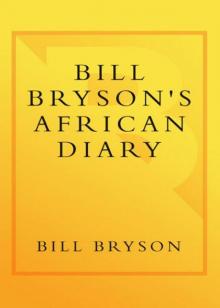 Bill Bryson's African Diary
Bill Bryson's African Diary